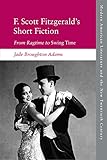F. Scott Fitzgerald’s Short Fiction : From Ragtime to Swing Time / Jade Broughton Adams.
Material type: TextSeries: Modern American Literature and the New Twentieth Century : MALN20CPublisher: Edinburgh : Edinburgh University Press, [2022]Copyright date: ©2018Description: 1 online resource (232 p.)Content type:
TextSeries: Modern American Literature and the New Twentieth Century : MALN20CPublisher: Edinburgh : Edinburgh University Press, [2022]Copyright date: ©2018Description: 1 online resource (232 p.)Content type: - 9781474424691
- 813/.52 23
- online - DeGruyter
| Item type | Current library | Call number | URL | Status | Notes | Barcode | |
|---|---|---|---|---|---|---|---|
 eBook
eBook
|
Biblioteca "Angelicum" Pont. Univ. S.Tommaso d'Aquino Nuvola online | online - DeGruyter (Browse shelf(Opens below)) | Online access | Not for loan (Accesso limitato) | Accesso per gli utenti autorizzati / Access for authorized users | (dgr)9781474424691 |
Frontmatter -- CONTENTS -- LIST OF FIGURES -- ACKNOWLEDGEMENTS -- ABBREVIATIONS -- Introduction: Not ‘a Sincere and Yet Radiant World’ but ‘Trashy Imaginings’ – Representations of Popular Culture in Fitzgerald’s Short Fiction -- CHAPTER 1 ‘Dancing Modern Suggestive Dances that are Simply Savagery’: Fitzgerald and Ragtime Dance -- CHAPTER 2 The ‘Chocolate Arabesques’ of Josephine Baker: Fitzgerald and Jazz Dance -- CHAPTER 3 ‘Satyre upon a Saxaphone’: Fitzgerald and Music -- CHAPTER 4 ‘The One about Sitting on His Top Hat and Climbing up His Shirt Front’: Fitzgerald and Musical Theatre -- CHAPTER 5 ‘A More Glittering, a Grosser Power’: Fitzgerald and Film -- Conclusion: ‘All My Stories are Conceived Like Novels’ -- APPENDIX: FITZGERALD’S SHORT STORY COLLECTIONS -- NOTES -- BIBLIOGRAPHY -- INDEX
restricted access online access with authorization star
http://purl.org/coar/access_right/c_16ec
A revisionist reading of Fitzgerald’s short stories through the lens of popular culture from the 1910s to the 1930sF. Scott Fitzgerald is remembered primarily as a novelist, but he wrote nearly two hundred short stories for popular magazines such as the widely-read Saturday Evening Post. These are vividly infused with the new popular culture of the early twentieth century, from jazz to motion pictures. By exploring Fitzgerald’s fascination with the intertwined spheres of dance, music, theatre and film, this book demonstrates how Fitzgerald innovatively imported practices from other popular cultural media into his short stories, showing how jazz age culture served as more than mere period detail in his work.Key FeaturesInterdisciplinary formal and thematic analysis of popular cultural references in Fitzgerald’s short fictionOffers fresh readings of longstanding concepts in Fitzgerald studies, such as his ‘double vision’Contributes to the growing field of popular cultural studies of modernist authors
Mode of access: Internet via World Wide Web.
In English.
Description based on online resource; title from PDF title page (publisher's Web site, viewed 29. Jun 2022)


